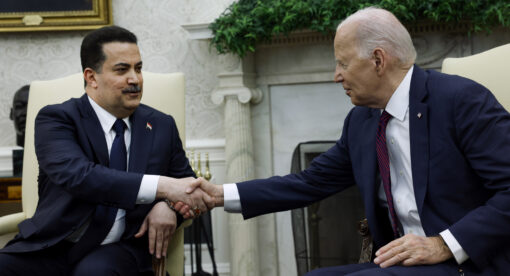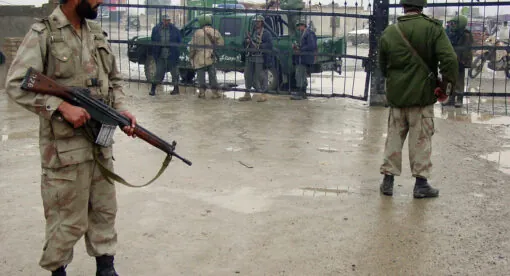The Weekly Forecast Monitor is a forward-looking assessment of geopolitical dynamics that are shaping the international system. To get more in-depth analysis of these issues and learn more about analytical products from New Lines Institute — including simulations, training sessions, and forecast reports — contact us at [email protected] and visit https://newlinesinstitute.org/analytical-products/. Download PDF version.
Global Hotspot Tracker
The Global Hotspot Tracker examines the outlook for key geopolitical hotspots around the world. (Go to the Global Connectivity Tracker)
Middle East
Summary – Tensions in the Middle East are trending toward military and hybrid escalation scenarios, as France considers placing economic pressure on Israel, and Turkey imposes trade restrictions. Cease-fire talks show little progress, and concerns of Iranian retaliation for a strike on its consulate in Damascus increase.
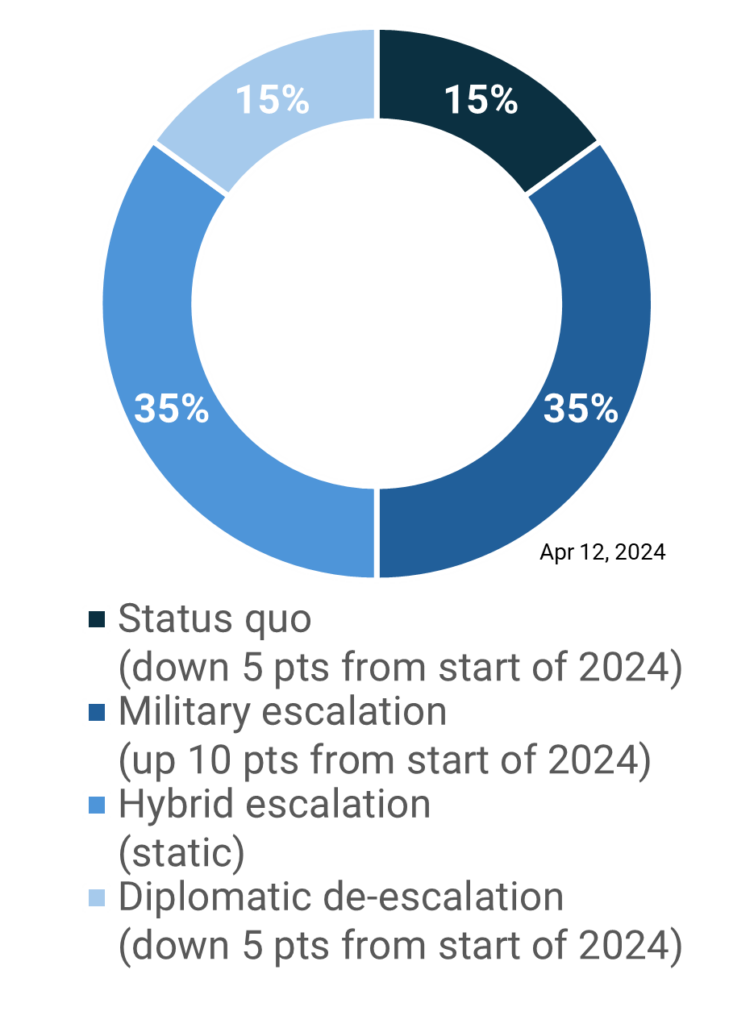
Military escalation scenario
- Bloomberg, citing U.S. intelligence reports, reported Iran could stage a major attack targeting Israeli sites in retaliation for Israel’s strike on Iran’s consulate in Damascus.
Risk level – high - The Israel Defense Forces reduced its presence in southern Gaza to “rest and refit,” raising concerns that it is preparing for a Rafah ground offensive.
Risk level – medium - A senior Iranian official warned Israeli embassies and consulates are not safe.
Risk level – high
Hybrid escalation scenario
- Iran may close the Strait of Hormuz, IRGC navy commander Alireza Tangsiri said, citing concerns about Israel’s presence in the UAE.
Risk level – high - Turkey announced trade restrictions on Israel in response to Israel’s offensive in Gaza.
Risk level – medium - France’s foreign minister said the country is considering sanctioning Israel to pressure Netanyahu to allow more humanitarian aid into Gaza.
Risk level – medium
Diplomatic de-escalation scenario
- Cease-fire talks continued in Cairo. Hamas said the latest Israeli proposal did not meet the group’s demands and no progress had been made.
Opportunity level – low
Russia/Ukraine Conflict
Summary – The Russia-Ukraine conflict is trending toward military and hybrid escalation scenarios as Russia carried out drone attacks in Kharkiv while Ukraine damaged a Russian warship in the Baltic Sea. The two countries continue to target each other’s energy infrastructure including a Russian strike against Kyiv’s largest power plant, while U.S. secondary sanctions are impacting Russian ally Belarus’ business ties with the United Arab Emirates. Both Russia and the U.S. paid diplomatic visits to China, with Russian Foreign Minister Sergey Lavrov discussing building strategic ties with Beijing while U.S. Treasury Secretary Janet Yellen warned Chinese companies against supporting Russia’s war in Ukraine.
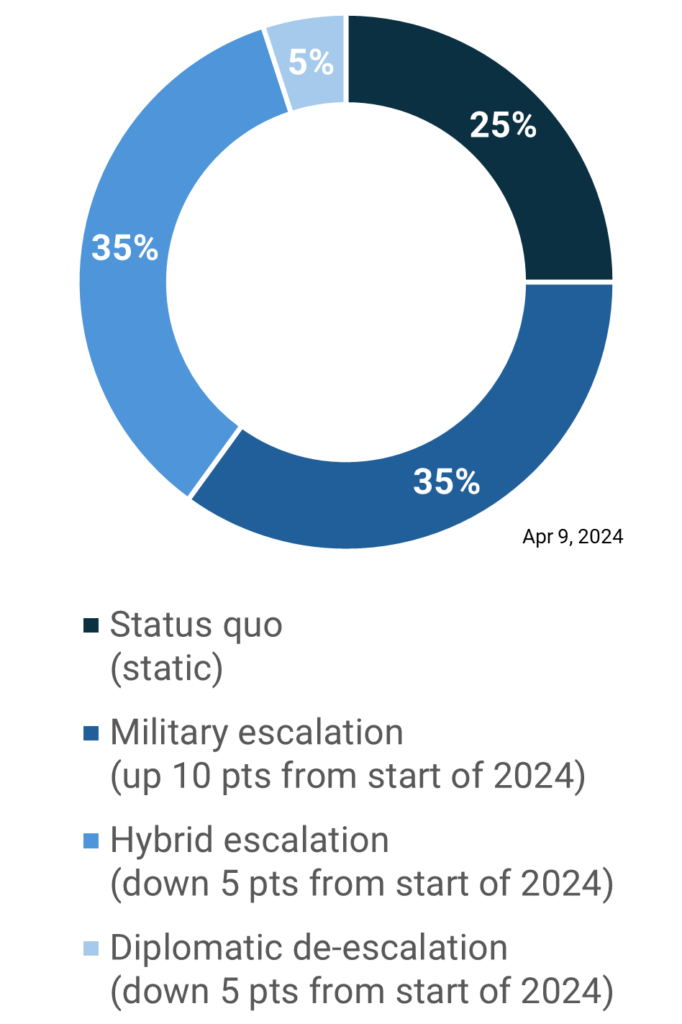
Military escalation scenario
- A Ukrainian special operation damaged a Russian warship in the Baltic Sea off the Kaliningrad exclave.
Risk level – low - Russia condemned a drone attack against a Russian military facility in the breakaway territory of Transnistria near the border with Ukraine.
Risk level – medium - Russia launched drone attacks against Kharkiv, Ukraine’s second largest city, killing six civilians, while Ukrainian drones attacked a flight school in the Russian city of Voronezh.
Risk level – low
Hybrid escalation scenario
- Russia hit the largest power plant in Kyiv as well as Ukrainian energy facilities in the regions of Kherson and Dnipro. Meanwhile, gasoline shortages prompted by Ukraine’s own attacks prompted Russia to seek 100,000 tons of gasoline from Kazakhstan.
Risk level – medium - Russia condemned Ukraine for striking the Zaporizhzhia nuclear power plant, which Russian forces had seized from Ukrainian control in the previous year.
Risk level – medium - During Yellen’s visit to Beijing, the U.S. warned China of ”significant consequences” if Chinese companies provide support for Russia’s war in Ukraine.
Risk level – medium - A major real estate developer from the UAE put property in Belarus up for sale due to the impact of secondary U.S. sanctions.
Opportunity level – low
Diplomatic de-escalation scenario
- No major indicators
U.S./China/Indo-Pacific
Summary – Tensions in the Indo-Pacific trended toward a hybrid escalation scenario, as Biden hosted a trilateral summit with Japan and the Philippines, which announced closer economic and military ties. After the summit, China summoned Japanese and Filipino diplomats to express concern over the summit. Chinese overcapacity was the primary focus of Yellen’s visit to China that continued into this week. The U.S. and its allies continue to open investigations into Chinese subsidy programs, as the EU launched an investigation into Chinese wind turbine subsidies this week. This comes as Australia announced its own subsidy program for its energy and manufacturing sectors.
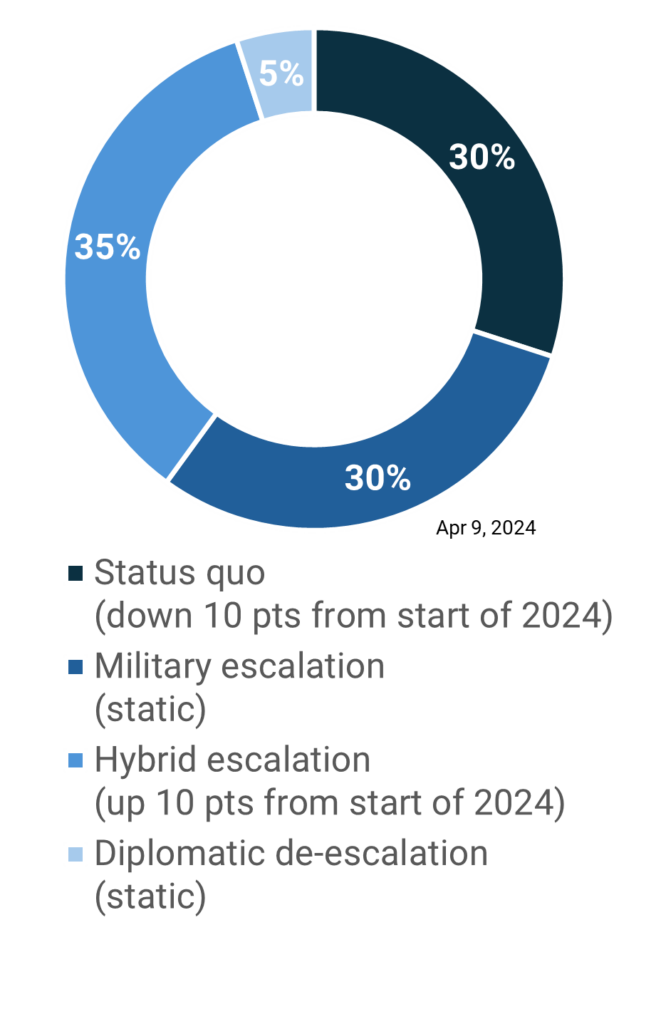
Military escalation scenario
- Japan and the U.S. announced closer military/security ties, as the two countries will restructure their alliance command and start coproducing weapons.
Risk level – medium - The U.S., Japan, Australia, and the Philippines conducted “maritime cooperative activities” in the South China Sea.
Risk level – low/medium - Taiwan will hold live-fire drills of its new Land Sword II missile between April 9-17 in Pingtung County.
Risk level – low
Hybrid escalation scenario
- The United States added four Chinese companies to the Commerce Department Entity List, after they sought to provide China’s military with U.S.-produced AI chips. Suppliers will need a license before selling goods to the listed companies.
Risk level – low/medium - The EU launched an investigation into Chinese wind turbine subsidies, following a trend of increasing economic tensions between China and the U.S. and its allies.
Risk level – medium - The U.S. asked Dutch chipmaker ASML to stop selling some equipment to Chinese buyers.
Risk level – medium
Diplomatic de-escalation scenario
- The U.S. State Department is considering easing China travel advisories.
Opportunity level – low - Chinese wheat buyers have canceled large shipments from the U.S. and Australia without explanation. In March, U.S. shipments totaling 504,000 tons of wheat were canceled. Roughly 1,000 tons of Australian shipments were cancelled or postponed.
Opportunity level – low/medium
Global Connectivity Tracker
The Global Connectivity Tracker examines the impact of geopolitical dynamics on global energy security and the climate transition. (Go to the Global Hotspot Tracker)
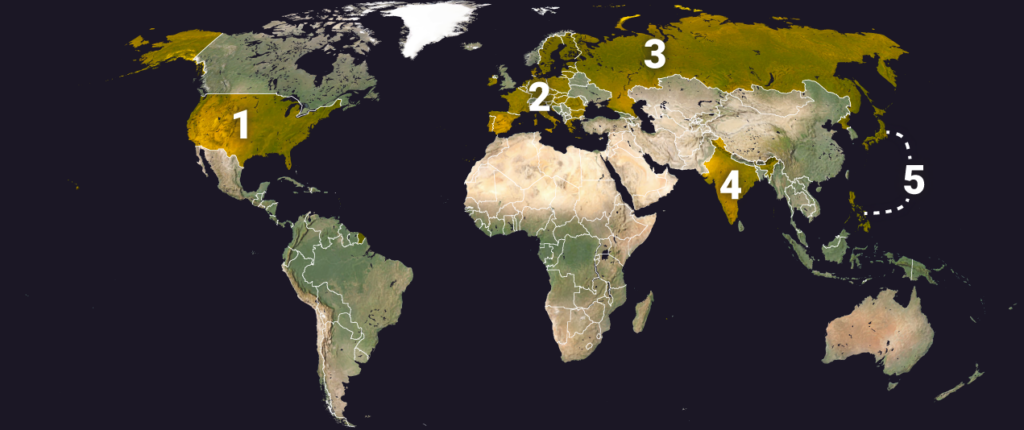
Energy/Climate
- United States
What happened: U.S. renewable energy production is breaking records. Wind and solar generation recently provided an unprecedented 76% of one day’s power needs on Texas’ principal grid. New England achieved a record the next day with 45% of generation coming from wind, solar, and hydropower.
Significance/Outlook: Solar, wind, and other renewable generation output have set records in the Midwest, New York, and mid-Atlantic during the last month. A combination of decreased demand caused by mild weather and the increase in output from renewable sources are primarily responsible for this rise in the proportion of green energy available on the national grid. More growth in renewable generation will be needed, however, to reduce emissions and meet the predicted future increase in electricity demand.
Opportunity level – low - European Union
What happened: The EU is investigating whether foreign subsidies enabled two Chinese companies to submit improper bids for a Romanian solar panel park with a capacity of 110 megawatts.
Significance/Outlook: This investigation under the Foreign Subsidies Regulation the EU enacted last year will serve to protect Europe’s economic security interests and competitiveness, as the strategic importance of green energy technologies increases. The EU, which imports solar panels to satisfy short- and long-term climate commitments, will look to balance those demands with the interests of local companies. The current European investigations aim to protect domestic sectors from state-subsidized clean technology imports from China. To minimize unfair competitive advantages, the EU executive might block contracts with Chinese enterprises it deems as having received subsidies. Continuous targeted investigations of Chinese clean energy technology companies by the EU, however, may harm China-EU economic relations.
Opportunity/Risk level – low
- Russia
What happened: Novatek, Russia’s second-largest natural gas producer, has put completion of its Arctic LNG 2 project on hold and plans to add an LNG facility in Murmansk after Western sanctions prevented its access to ice-class gas tanker ships.
Significance/Outlook: After a major rupture with the West over Ukraine, Russian pipeline gas supplies to Europe have plunged to post-Soviet lows. With Arctic LNG 2 hobbled by a lack of available tankers, this Murmansk LNG project will help Russia enhance seaborne LNG sales to Europe to make up for lower pipeline gas shipments. The Murmansk project would allow Russia to significantly increase LNG production and exports. The Murmansk facility’s access to an ice-free port gives it an advantage over Arctic LNG 2. The Murmansk project is projected to eventually produce 20.4 million tonnes per year, surpassing Arctic LNG 2. The project’s first two trains are expected to begin production by 2027, and the remaining line in 2029.
Opportunity level – low - India
What happened: India has boosted domestic sales of electric vehicles by increasing investments and relaxing import tax regulations.
Significance/Outlook: India has made EVs a priority in its fast-growing renewable energy sector as it focuses on cleaner mobility strategies. Road transport is responsible for 12% of India’s energy-related CO2 emissions and is a significant contributor to urban air pollution. To tackle that, the Indian government boosted investments to help ensure the efficiency and viability of EVs and hybrids. In 2023, electric vehicles accounted for 2% of total sales, which the government aims to increase to 30% by 2030. In March, the Indian government reduced import taxes on specific EV models, provided that manufacturers commit to investing a minimum of $500 million and commence local production within three years.
Opportunity level – medium/low - Japan/Philippines
What happened: In an effort to mitigate China’s influence, Japan, the United States, and the Philippines are pursuing increased cooperation on supply chains for critical minerals.
Significance/Outlook: The trilateral collaboration was formalized through a joint statement after a summit in Washington, D.C., on April 11, involving Japanese Prime Minister Fumio Kishida, U.S. President Joe Biden, and Philippines President Ferdinand Marcos Jr. The cooperation aims to include research collaborations among top institutions focusing on crucial and emerging technologies such as artificial intelligence, quantum computing, semiconductors, and clean energy, thereby thwarting China’s economic pressures. Japanese and U.S. officials believe that bolstering cooperation with the Philippines is crucial in addressing security concerns such as a potential conflict in the Taiwan Strait.
Opportunity level – low
Key Stats of the Week
- The U.S. installed 32.7 gigawatts (GW) of battery, solar, and wind capacity in 2023, topping the 2021 high of 31.5 GW, according to EIA data.
- To cut emissions 32 to 51% from 2005 levels in accordance with climate target goals, the U.S. must add 32 to 95 GW of new wind and solar capacity annually until 2035.
- U.S. power demand, which rose 1.4 percent in 2023, is projected to climb at a rate of 2.3 percent annually over the next decade.
Source: U.S. Energy Information Administration



